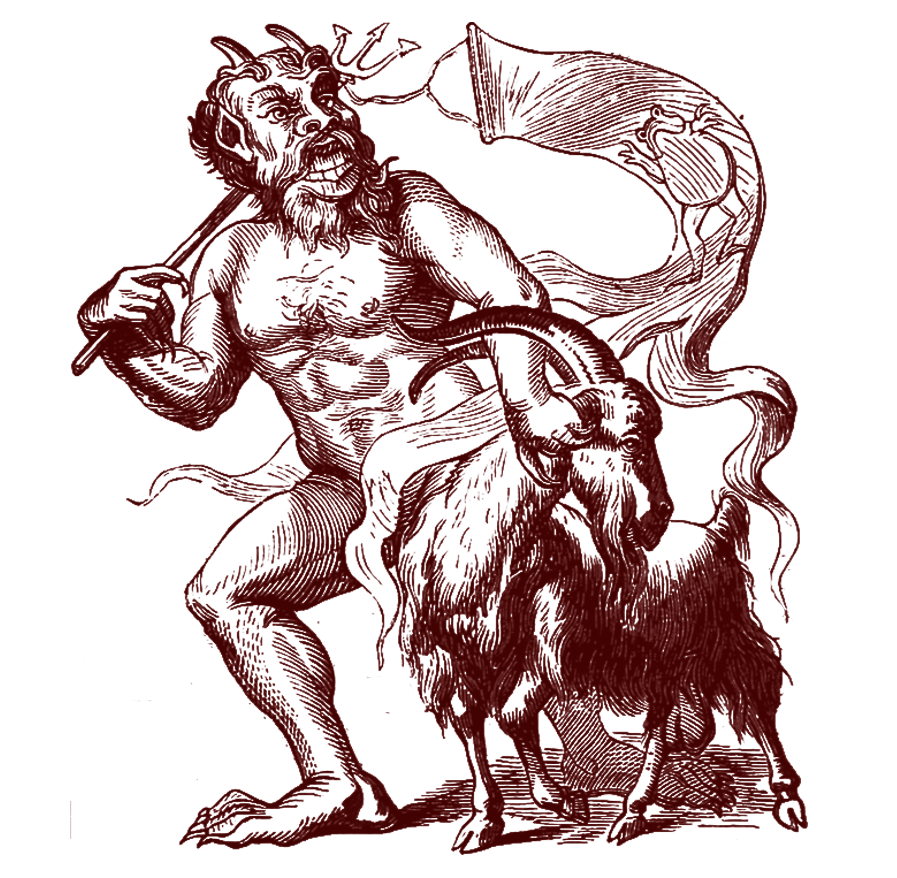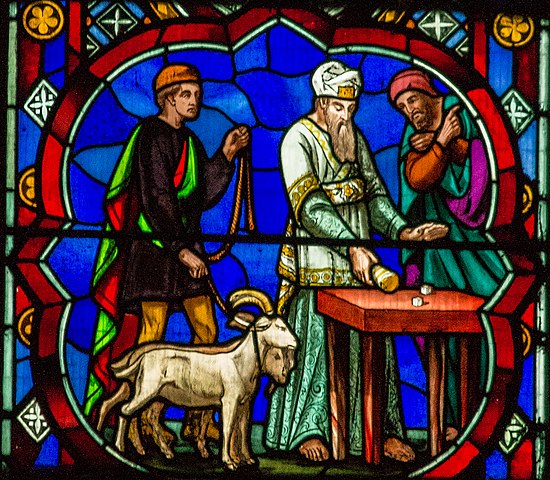Azazel
- Not to be confused with Zazel, the spirit of Saturn.

Azazel is a fallen angel associated with forbidden knowledge and the rite of the scapegoat in traditional Jewish rituals.
According to The Expositor's Bible Commentary, "Azazel" is the Hebrew word meaning "scapegoat." This is the only place that the Hebrew word is found in the entire Old Testament. It says that the Book of Enoch is full of demonology and reference to fallen angels. The EBC (Vol 2) suggests that this text uses late Aramaic forms for these names which indicates that The Book of Enoch most likely relies upon the Hebrew Leviticus text rather than the Leviticus text being reliant upon the Book of Enoch.
He is ruled over by Archangel Gabriel.
Biblical tradition
In the Hebrew Bible, the term is used three times in Leviticus 16, where two male goats were to be sacrificed to Yahweh and one of the two was selected by lot, for Yahweh is seen as speaking through the lots. One goat is selected by lot and sent into the wilderness לַעֲזָאזֵל, "for Azazel." This goat was then cast out in the desert as part of Yom Kippur. The scapegoat ritual can be traced back to 24th century BC Ebla, from where it spread throughout the ancient Near East.
Greek Septuagint and later translations
The translators of the Greek Septuagint understood the Hebrew term as meaning "the sent away" (apparently reading either עז אזל goat which leaves or the mighty sent or עזלזל), and read:
And Aaron shall cast lots upon the two goats, one lot for the Lord and the other lot for the scapegoat. And Aaron shall present the goat on which the lot fell for the Lord, and offer it as a sin offering; but the goat on which the lot of the sent away one fell shall be presented alive before the Lord to make atonement over it, that it may be sent away into the wilderness.
Jewish rite of the scapegoat
The Mishnah (Yoma 39a) follows the procedure outlined in the Biblical text: two goats were procured, similar in respect of appearance, height, cost, and time of selection. Having one of these on his right and the other on his left, the high priest, who was assisted in this rite by two subordinates, put both his hands into a wooden case, and took out two labels, one inscribed "for Yahweh" and the other "for Azazel."
The high priest then laid his hands with the labels upon the two goats and said, "A sin-offering to Yahweh" (thus speaking the Tetragrammaton); and the two men accompanying him replied, "Blessed be the name of His glorious kingdom for ever and ever." He then fastened a scarlet woolen thread to the head of the goat "for Azazel;" and laying his hands upon it again, recited the following confession of sin and prayer for forgiveness: "O Lord, I have acted iniquitously, trespassed, sinned before Thee. I, my household, and the sons of Aaron Thy holy ones. O Lord, forgive the iniquities, transgressions, and sins that I, my household, and Aaron's children, Thy holy people, committed before Thee, as is written in the law of Moses, Thy servant, 'for on this day He will forgive you, to cleanse you from all your sins before the Lord; ye shall be clean.'"
This prayer was responded to by the congregation present. A man was selected, preferably a priest, to take the goat to the precipice in the wilderness; and he was accompanied part of the way by the most eminent men of Jerusalem. Ten booths had been constructed at intervals along the road leading from Jerusalem to the steep mountain. At each one of these the man leading the goat was formally offered food and drink, which he, however, refused. When he reached the tenth booth those who accompanied him proceeded no further, but watched the ceremony from a distance. When he came to the precipice he divided the scarlet thread into two parts, one of which he tied to the rock and the other to the goat's horns, and then pushed the goat down (Yoma vi. 1–8). The cliff was so high and rugged that before the goat had traversed half the distance to the plain below, its limbs were utterly shattered. Men were stationed at intervals along the way, and as soon as the goat was thrown down the precipice, they signaled to one another by means of kerchiefs or flags, until the information reached the high priest, whereat he proceeded with the other parts of the ritual.
The scarlet thread is symbolically referenced in Isaiah 1.18; and the Talmud states (ib. 39a) that during the forty years that Simeon the Just was High Priest of Israel, the thread actually turned white as soon as the goat was thrown over the precipice: a sign that the sins of the people were forgiven. In later times the change to white was not invariable: a proof of the people's moral and spiritual deterioration, that was gradually on the increase, until forty years before the destruction of the Second Temple, when the change of color was no longer observed (l.c. 39b).
Jewish opinion
The medieval scholar Nahmanides (1194–1270) identified the Hebrew text as also referring to a demon, and identified this "Azazel" with Samael. However, he did not see the sending of the goat as honoring Azazel as a deity, but as a symbolic expression of the idea that the people's sins and their evil consequences were to be sent back to the spirit of desolation and ruin, the source of all impurity. The very fact that the two goats were presented before God, before the one was sacrificed and the other sent into the wilderness, was proof that Azazel was not ranked alongside God, but regarded simply as the personification of wickedness in contrast with the righteous government of God.
Ida Zatelli (1998) has suggested that the Hebrew ritual parallels pagan practice of sending a scapegoat into the desert on the occasion of a royal wedding found in two ritual texts in archives at Ebla (24th C. BC). A she-goat with a silver bracelet hung from her neck was driven forth into the wasteland of 'Alini' by the community. There is no mention of an "Azazel."
In Christianity
The Vulgate contains no mention of "Azazel" but only of caper emissarius, or "emissary goat," apparently reading עז אזל as "goat."
English versions, such as the King James Version, followed the Septuagint and Vulgate in understanding the term as relating to a goat. In older English versions of the Bible, such as the King James Version, the phrase la-azazel is translated as "as a scapegoat;" however, in most modern English Bible translations, it is represented as a name in the text:
Aaron shall offer the bull as a sin offering for himself, and shall make atonement for himself and for his house. He shall take the two goats and set them before the Lord at the entrance of the tent of meeting; and Aaron shall cast lots on the two goats, one lot for the Lord and the other lot for Azazel. Aaron shall present the goat on which the lot fell for the Lord, and offer it as a sin offering; but the goat on which the lot fell for Azazel shall be presented alive before the Lord to make atonement over it, that it may be sent away into the wilderness to Azazel.
— Leviticus 16:6–10, New Revised Standard Version
The modern English Standard Version provides the footnote "16:8 The meaning of Azazel is uncertain; possibly the name of a place or a demon, traditionally a scapegoat; also verses 10, 26". Most scholars accept the indication of some kind of demon or deity, however Judit M. Blair notes that this is an argument without supporting contemporary text evidence.
In his "Contra Celsum" (vi. 43), Origen, an early Christian apologist, identifies Azazel with Satan.
In Islam
In Islam, Azazel appears in relation to the story of Harut and Marut, a pair of angels mentioned in the Quran. Although not explained by the Quran itself, Muslim exegetes, such as Al-Kalbi and Al-Tha`labi, usually linked the reason of their abode to a narration related to the Watchers known from 3 Enoch. Just as in 3 Enoch, angels complained about humans iniquity, whereupon God offered a test, that the angels might choose three among them to descend to earth, endowed with bodily desires, and prove that they would do better than humans under the same conditions.
Accordingly, they choose Aza, Azzaya and Azazel. However, Azazel repented his decision and God allowed him to turn back to heaven. The other two angels failed the test and their names were changed to Harut and Marut. They ended up on earth, introducing men to illicit magic.
Enochian literature
In the Dead Sea Scrolls, the name Azazel occurs in the line 6 of 4Q203, The Book of Giants, which is a part of the Enochic literature found at Qumran. To date, this remains the earliest evidence of Azazel as a demon or god.
The Book of Enoch brings Azazel into connection with the Biblical story of the fall of the angels, located on Mount Hermon, a gathering-place of demons of old. Here, Azazel is one of the leaders of the rebellious Watchers in the time preceding the Flood; he taught men the art of warfare, of making swords, knives, shields, and coats of mail, and taught women the art of deception by ornamenting the body, dyeing the hair, and painting the face and the eyebrows, and also revealed to the people the secrets of witchcraft and corrupted their manners, leading them into wickedness and impurity until at last he was, at Yahweh's command, bound hand and foot by the Archangel Raphael and chained to the rough and jagged rocks of [Ha] Dudael (= Beth Ḥadudo), where he is to abide in utter darkness until the great Day of Judgment, when he will be cast into the fire to be consumed forever.
According to the Book of Enoch, Azazel (here spelled ‘ăzā’zyēl) was one of the chief Grigori, a group of fallen angels who married women. Many believe that this same story (without any mention of Azazel) is told in the Book of Genesis 6:2–4. These "sons of God" have often been thought of as fallen angels, and are sometimes equated with the Nephilim.
In the fifth-century 3 Enoch, Azazel is one of the three angels (Azza [Shemhazai] and Uzza [Ouza] are the other two) who opposed Enoch's high rank when he became the angel Metatron. While they were fallen, at this time they were still in Heaven, but Metatron held a dislike for them, and had them cast out.
Several scholars believe that some details of Azazel's punishment are reminiscent of the scapegoat rite. Lester Grabbe points to a number of parallels between the Azazel narrative in Enoch and the wording of Leviticus 16, including "the similarity of the names Asael and Azazel; the punishment in the desert; the placing of sin on Asael/Azazel; the resultant healing of the land."
In the Apocalypse of Abraham
In the extra-canonical text the Apocalypse of Abraham (c.1st CE), Azazel appears as an unclean bird who came down upon the sacrifice which Abraham prepared.
The text also associates Azazel with the serpent and Hell. In Chapter 23, verse 7, it is described as having seven heads, 14 faces, "hands and feet like a man's [and] on his back six wings on the right and six on the left." Here there is the idea that God's heritage (the created world) is largely under the dominion of evil – i.e., it is "shared with Azazel" (Abr. 20:5), again identifying him with the Devil, who was called "the prince of this world" by Jesus.
Abilities

Azazel was responsible for teaching people to make weapons and cosmetics, for which he was cast out of heaven. The Book of Enoch 8:1–3a reads, "And Azazel taught men to make swords and knives and shields and breastplates; and made known to them the metals and the art of working them; and bracelets and ornaments; and the use of antimony and the beautifying of the eyelids; and all kinds of costly stones and all colouring tinctures. And there arose much godlessness, and they committed fornication, and they were led astray and became corrupt in all their ways."
Legacy
Azazel has become a common name associated with demonic deities. Angeline Tubbs, the Witch of Saratoga, was said to keep an altar devoted to Azazel and had made a pact with him to lengthen her life.
The Coven of the Catta believed that Azazel was another name for the Mesopotamian Sun god Utu, also known by its Akkadian name, Shamash. The drew this conclusion from the fact that both deities were responsible known as "Lord of Riches" and the "Artificer of Metals." The coven also considered Azazel the brother of Lilith.
Azazel was utilized as the Ace of Wands card in the Occult Tarot by Travis McHenry.
In the film Fallen, starring Denzel Washington, Azazel was a demonic entity passed from person to person by touch.
In the CW TV series Supernatural, Azazel is the main antagonist in seasons one and two.
